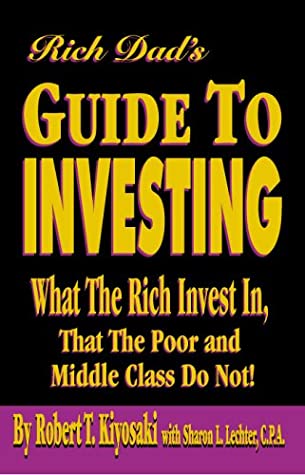

 |

|

The average rating for Rich Dad's Guide to Investing: What the Rich Invest in That the Poor and Middle Class Do Not! based on 2 reviews is 3.5 stars.
Review # 1 was written on 2010-07-11 00:00:00 Tom Daily Tom DailyLike all Kiyosaki’s books that I’ve read so far (Rich Dad, Poor Dad, Cashflow Quadrant: Rich Dad's Guide to Financial Freedom, Rich Dad's Retire Young, Retire Rich), this one is more about developing the proper mental attitude to become rich, rather than a step-by-step handbook. He opens your eyes to the possibilities of obtaining wealth, gives a few general pointers, then leaves it up to you (and your financial team) to work out the details. His books are more strategic than operational, although there are operational tips sprinkled throughout. Kiyosaki says that average investors invest to obtain comfort and security, but the rich invest primarily to become rich, and secondarily for comfort and security. He advises that you take advantage of the legal benefits of business ownership, acquiring assets as a business to minimize taxes. The book’s subtitle promises to reveal what the rich invest in, that the poor and middle class do not. Kiyosaki says that average investors invest from the outside, through public stocks and mutual funds. He says that the real money is made by the rich when they invest from the inside: through businesses they start and then sell or take public, companies they invest in pre-IPO, and real estate. He also promotes hedges and "bear" investments to profit during market downturns, as well as traditional investments such as stocks and bonds. He strongly recommends that you assemble a financial team of lawyers, accountants, and financial advisers. Kiyosaki summarizes this book near the end: "In order to create a world of an abundance of money it does require a degree of creativity, a high standard of financial and business literacy, seeking opportunities rather than seeking more security, and to be more cooperative instead of competitive." The book is divided into 3 phases. Phase 1 explains 13 Investor Lessons. Phase 2 describes several types of investors of increasing sophistication. In Phase 3, Kiyosaki presents his fundamentals for building a strong business. If you’re looking for a book full of stock tips or real estate investing advice, this isn’t it. Instead, it contains general principles for starting and running a successful business, and advice on investing through that business. I liked Kiyosaki’s advice to be an investor first, regardless of your profession. His nontraditional view of expenses is also thought-provoking: he says that debt, expenses, and losses are good, powerful forms of leverage when used to generate cash flow. Investor Lessons Lesson 1: Invest first to be rich, then to be comfortable and secure. Lesson 5: Plan to be rich, not poor. Plan for financial abundance, not scarcity. Expand your financial vocabulary to expand your financial reality. Lesson 6: Find a simple formula for getting rich and stick to it. Investing is a system; a dull, boring, almost mechanical process. Lesson 9: Investing for comfort and security takes money, and is passive. Investing to be rich requires time, and is active. Lesson 10: The real money comes from legal inside investing. Notes • To become rich, create assets rather than buying them. This is usually done by starting a business. • Profit during down markets with short selling, put options, and other hedges. • With earned income, you work for money and pay more taxes. With passive and portfolio income, your money works for you, and you pay fewer taxes. • Microcaps have the highest returns. Become an inside investor by starting a business, or taking a controlling interest in an existing one. • A business buys its assets with gross income, and pays taxes on net income. An individual/employee pays taxes on gross income, and buys assets with net income. • To reduce your taxes, you want high expenses and low income, not low expenses and high income. |
Review # 2 was written on 2008-06-04 00:00:00 William Smith William SmithMuch like all of the Rich Dad Roor dad series, this book was good, but not necessarily great. For me, it's a bit too generic and conceptual, and not not quite specific enough. However, there's not too many great alterntives in my opinion so this is still a decent and valid read. The author does have a tendency to repeat himself in his books, as well as push/advertise for his various other products. I'm not a fan of purchasing a 200 page book and getting 10% advertising. All in all, while not perfect, it's still good, valid and a worthwhile read. |
CAN'T FIND WHAT YOU'RE LOOKING FOR? CLICK HERE!!!